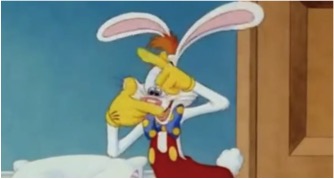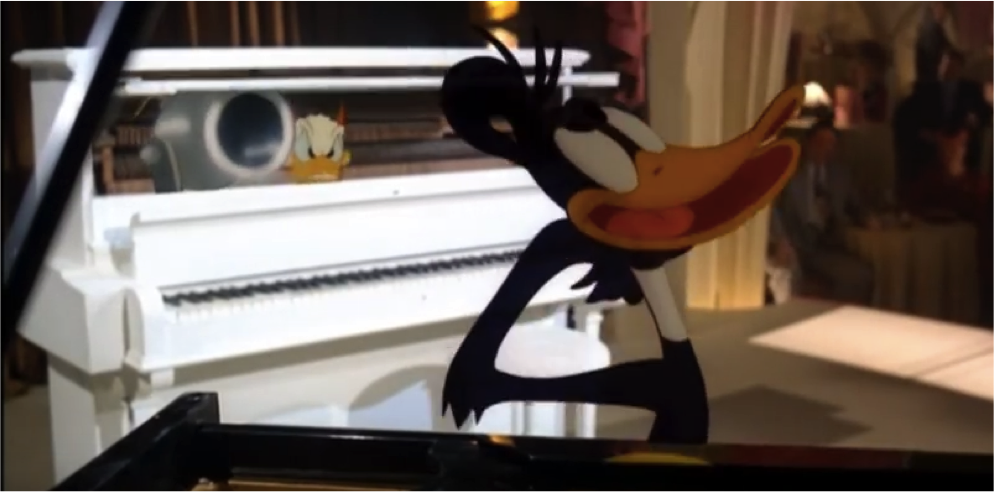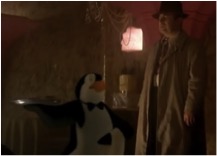Robert Zemeckis’s Who Framed Roger Rabbit (1988) is set in the ‘Toon’-dominated animated film industry of Hollywood in 1947, 40 years previous to the film’s actual release. [1] Eddie Valiant (Bob Hoskins), [2] a private investigator and the film’s human protagonist, ends his hiatus from sleuthing, caused by his brother: his professional partner’s Toon-related death, after receiving a high-profile investigatory request from R.K. Maroon (Alan Tilvern). Maroon, owner of Maroon Cartoon Studios, Hollywood’s leading fictional cartoon studios and production company, pays Valiant to take divisive photos of Jessica Rabbit (voiced by Kathleen Turner) playing ‘patty-cake’ with the owner of ToonTown and the Acme Corporation, Marvin Acme (Stubby Kaye). Soon after these photos of Jessica’s betrayal are shown to her ‘famous’ Toon husband, the film’s loveable, anthropomorphic, animated animal protagonist, Roger Rabbit (voiced by Charles Fleischer), Acme is suspiciously murdered and all fingers point to Roger. Roger turns to Valiant for help in clearing his name and finding out the truth. Valiant, who is unwilling to help at first, as he harbours questionable animosity towards Toon-kind, realises he is responsible for accidentally giving Roger a motive for Acme’s murder by showing him the photographs of Jessica, and thus begrudgingly agrees to help him. Valiant and Roger’s search for the truth behind Acme’s murder is a live-action and animation adventure which leads the protagonists to form the most unpredictable, unforeseen, Toon-animal/human friendship.
Who Framed Roger Rabbit is both a hybrid mix of film formats: as it combines live-action and animation and also successfully demonstrates a hybrid mix of cinematic genres: as it contains many features characteristic of contrasting cinematic categories: including crime/detective, fantasy, adult animation and comedy. The film’s “novelty combination”, [3] a term the film’s Director of Animation Richard Williams used to describe the interplay of the two different film formats in ‘Behind the Ears: The True Story of Roger Rabbit’, is what makes the film so interesting to watch, as the two worlds: ‘real’ and ‘Toon’ are seamlessly blended and shown to interact. It is this successful interaction between toon and live-action that makes Valiant and Roger’s blossoming friendship so exciting to watch as well as making Toon-kind’s struggle for equality in the human-world so frustrating to the viewer, due to Toons’ obvious equality highlighted symbolically through the two worlds blending seamlessly.
The film’s use of the live-action, animation combination contorts characteristics of genres that the film could be categorised as, such as comedy. A comedy duo would predominantly, especially around the time of the film’s initial release, be comprised of either two ‘real’ human males or, if it were conforming to the constraints popular cartoon/animated comedies had created, it would be comprised of two anthropomorphic animals, like Looney Toons’ Bugs Bunny and Daffy Duck or Tweety and Sylvester the Cat. This comedy duo flouts both of these characteristically comedic dynamics by pairing a live-action ‘straight man’ [4] and funny, animated, anthropomorphic ‘Toon’ rabbit, to much success. This differently formatted duo’s friendship helps highlight the possibility of harmony between Toons and humans, as well as animals and humans.
The film cleverly begins in full animated ‘short’, cartoon format, adhering to all the stereotypical aesthetic tropes of the classic cartoons of the 1940’s era the film is set in: the ‘Golden age of Animation’. [5] Following a cliché, short, garish opening title sequence involving the characters’ faces, the production company’s name and the title of the cartoon coupled with some upbeat, lively, comedic music, we are introduced to Roger Rabbit, who is immediately humanised.
Roger’s ‘livelihood’ is highlighted to us, as, at barely four minutes into the film we see the near-human, comically-clothed: in brightly-coloured dungarees and bow-tie, anthropomorphic rabbit pleading with his human boss to keep his job: “I can give you stars, just drop the refrigerator on my head one more time”, [6] and realise that this ‘entertaining’ cartoon is actually Roger’s reality. Prior to this pleading, Roger is hurt in all manner of ways, including having numerous harmful Acme products dropped on him, accidentally locked in a hot oven and electrocuted by two plug sockets. The exemplification of Roger’s dangerous ‘profession’ and his immediate near-humanisation, seeks to suggest that there’s a need for cartoons to distance the ‘Toon’ animal – that the human audience is finding entertainment in the harm of, from ‘real’ animals, by making the Toon animal more like ourselves so that we don’t feel sympathy or guilt when it’s hurt, just morally and ethically questionable amusement. This makes us question why this popular type of classic animation, which this framed opening cartoon adheres to the tropes of, was so entertaining when it involved ‘animals’ being harmed.
Maroon Toons, the production company that Roger is a contracted employee of, harms him to entertain their human viewers: though it is noted that Toons can survive almost anything “he’s a Toon, you can drop anything on his head, he’ll shake it off”. Regardless of Roger’s not being permanently ‘harmed’, this degradation, and that of other Toon animals throughout the film for human entertainment, seeks to highlight humans’ capacity for the exploitation of animals in real life. Roger’s production company employer’s seeming disregard for his physical limits and boundaries when performing could be read as a social comment on the exploitation of human actors and human stunt actors in real life too. The severe physical exertion that Roger’s employers demand from him in order for their productions to have maximum comedic value could be symbolic of the physical and psychological limits that many human actors in real life are encouraged to go beyond, in their performances, for ‘entertainment’s sake’.
Baby Herman, the ‘human’ Toon in the beginning cartoon, isn’t harmed at all, a fact which symbolically cements the divide between animals and human-representative Toons, a segregation which is also symbolic of the divide between humans and animals in real life. The humans in this film see Toons as existing purely to serve their needs, something that a majority of humankind believes in real life: be that for entertainment, companionship or food. Thus we are supposed to question the morality of this.
Opening Cartoon scene:https://youtu.be/cTcG3sYJz74
Another scene in which animal characters are shown to be subordinate to human characters is that in which Jessica Rabbit performs at ‘the Ink and Paint Club’. This is an important scene, as an animated, anthropomorphic male animal double-act, Daffy and Donald Duck, who are of the same format and species, unlike Roger and Valiant, entertain their human audience more through their slapstick humour: which involves them harming each other, than by the piano duet/duel that they’re paid to do. Marvin Acme cements the human-audiences’ belief of the real source of their entertainment through his line, “those ducks are funny, they never get to finish the act”, suggesting that their act is only entertaining because they get distracted by hurting each other instead of continuing to play the piano.
This duel, though another filmic occurrence of animal subjugation, subordination and exploitation, is clever as Daffy is a Warner Brothers creation and Donald Duck is of Disney origin, thus this duel subconsciously highlights the rivalry between the cartoon production studios during the ‘Golden Age of Animation’.
Every other Toon animal featured in this scene is visibly subservient and tending to human’s needs. Toon penguins are seen darting about the club serving drinks to the human guests; a gorilla is working as the club’s security guard and a fictional octopus-like character is the barman. All this suggests that Toon animals, representative of ‘real’ animals, are exploited in both the service and entertainment industries, as highlighted by R.K. Maroon, “best thing is, they work for peanuts”. However, as we see Toon animals predominantly entertaining humans throughout the film, and are made to believe that this is their primary employment, a belief cemented by Roger’s comment, “but I’m a Toon, Toon’s are supposed to make people laugh”, it could be suggested that these animals are ‘out-of-work’ and have found temporary employment in a seemingly exploitative service industry. These Toon animals could thus be seen to be symbolic for out-of-work human actors in real life being exploited by the service industries.
Throughout Who Framed Roger Rabbit, Toon animals, when in the human/live-action realm, are only ever seen to be working, serving and/or entertaining humans. Even in their fantasy, animated district of ToonTown they are still subject to human powers, as human Marvin Acme owns the town. This suggestion of inescapable human power is symbolic of humankinds’ real life belief, that animals live within ‘humans’’ world and thus under ‘humans’’ rule. Semi-contrastingly, the human-representative Toons in the film, e.g. Jessica Rabbit and Betty Boop have a more elevated social status than their animal-counterparts, as they are both highly-sexualised and are thus objects of lust and adoration to the humans, rather than of degrading comedic entertainment. Interestingly, no species boundaries seem to exist within Toon-kind, as Jessica a ‘human’ Toon, is happily and non-shamefully married to Roger Rabbit.
Who Framed Roger Rabbit is an intelligent film: it successfully demonstrated a quasi-revolutionary – when first released, hybrid combination of live-action and animation formats, put across social and moral questions of why cartoons: which are stereotypically centred around the harm of ‘animal’ characters, are entertaining to humans and it created one of the first successful, symbolic, heart-warming human/Toon-animal friendships. Equally importantly, it metaphorically highlights the politically and ethically wrong exploitative nature of humans and their use of animals for entertainment. The film’s Executive Producer, Steven Spielberg, said of the creation and production of the film, “it’s going to take a long time, but if done right it could be […] something that no one’s ever seen before”, [7] and even I, viewing it nearly three decades after its initial release, thoroughly agree, it resembles no other film I have yet seen.
Suggested Further Reading
TvTropes.org, ‘The Straight Man’, http://tvtropes.org/pmwiki/pmwiki.php/Main/StraightMan
TvTropes.org, ‘The Golden Age of Animation’, http://tvtropes.org/pmwiki/pmwiki.php/Main/TheGoldenAgeOfAnimation
Gary K. Wolf, Who Censored Roger Rabbit? (New York: St. Martin’s Press, 1981)
Bibliography
Who Framed Roger Rabbit, Dir. Robert Zemeckis, Buena Vista Distribution Inc, 1988.
IMDB, ‘Who Framed Roger Rabbit’, International Movie Database, http://www.imdb.com/title/tt0096438/ [accessed 24/11/2015]
Behind the Ears: The True Story of Roger Rabbit, Buena Vista Home Entertainment, 2003, https://www.youtube.com/watch?v=JFqB2VFGWJU [accessed 25/11/2015]
TvTropes.org, ‘The Golden Age of Animation’, http://tvtropes.org/pmwiki/pmwiki.php/Main/TheGoldenAgeOfAnimation [accessed 25/11/2015]
TvTropes.org, ‘The Straight Man’, http://tvtropes.org/pmwiki/pmwiki.php/Main/StraightMan, [25/11/2015]
[1] Who Framed Roger Rabbit, Dir. Robert Zemeckis, Buena Vista Distribution Inc, 1988.
[2] IMDB, ‘Who Framed Roger Rabbit’, International Movie Database, http://www.imdb.com/title/tt0096438/ [accessed 24/11/2015]
[3] Behind the Ears: The True Story of Roger Rabbit, Buena Vista Home Entertainment, 2003, https://www.youtube.com/watch?v=JFqB2VFGWJU [accessed 25/11/2015]
[4] TvTropes.org, ‘The Straight Man’, http://tvtropes.org/pmwiki/pmwiki.php/Main/StraightMan, [accessed 25/11/2015]
[5] TvTropes.org, ‘The Golden Age of Animation’, http://tvtropes.org/pmwiki/pmwiki.php/Main/TheGoldenAgeOfAnimation [accessed 25/11/2015]
[6] Who Framed Roger Rabbit, Dir. Robert Zemeckis, Buena Vista Distribution Inc, 1988 – all direct speech quotes will be from this film unless otherwise stated.
[7] Behind the Ears: The True Story of Roger Rabbit, Buena Vista Home Entertainment, 2003, https://www.youtube.com/watch?v=JFqB2VFGWJU [accessed 25/11/2015]


